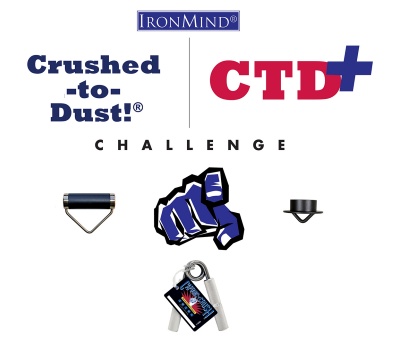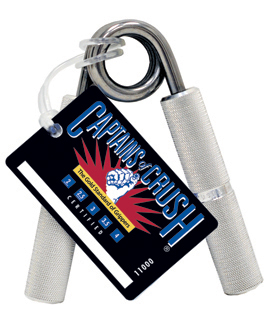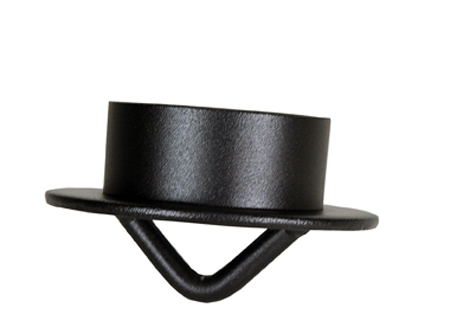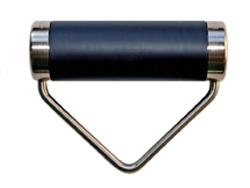Crushed-to-Dust!® and CTD+ Challenge
Official Rules for Certification

Meet the Challenge and join the Crushed-to-Dust! and CTD+ certification lists!
How to certify on the Crushed-to-Dust! and CTD+ Challenge!
Crushed-to-Dust! Challenge at a glance
Close a Captains of Crush No. 2 gripper, lift 20 kg/45 lb. on an IronMind Hub and lift 90 kg/200 lb. on the Rolling Thunder—the Crushed-To-Dust!® Challenge is that simple. Not just for grip strength specialists, the IronMind Crushed-To-Dust!® Challenge is perfect for lifters, climbers, CrossFitters, cops, firefighters, military, MMA, OCR . . . everyone who uses their hands on the job or at play. The Crushed-to-Dust!® Challenge is an easily accessible and quick way to demonstrate superior all-around grip strength, based on universal tests of grip strength and designed by IronMind—Grip Central since 1988. Crushed-To-Dust!® performance levels for women are noted below.
The IronMind Crushed-to-Dust! Challenge has three elements:
1) Close a No. 2 Captains of Crush gripper
2) Lift 20 kg/45 lb.* on an IronMind Hub
Crushed-To-Dust!® Standards for Women
The same implements and rules that define the Crushed-To-Dust! Challenge are used for women, and the required performance level for each event is as follows:
- Close a Captains of Crush Point Five gripper
- Lift 13 kg/28 lb. on an IronMind Hub
- Lift 53 kg/117 lb. on an IronMind Rolling Thunder
Crushed-To-Dust!® Plus (CTD+) Standards
The same implements and rules that define the Crushed-To-Dust! Challenge are used for the CTD+, except that one must be certified on the Captains of Crush No. 3 gripper to be eligible, and the required performance level for each event is as follows:
- Close a Captains of Crush No. 3 gripper
- Lift 35 kg/77 lb. on an IronMind Hub
- Lift 115 kg/254 lb. on an IronMind Rolling Thunder
Only genuine IronMind® products may be used and they must be the current model of each; if you have any questions about your equipment, please contact IronMind® before starting the challenge. The challenge must be completed within three minutes of starting the first event. The events may be completed in any order. Click here for CTD Challenge Official Referee Form or for CTD+ Challenge Official Referee Form.
*total weight: Hub, loading pin, carabiner, and plates (Hub + pin + carabiner = 5 lb. / 2.26 kg)
**total weight: Rolling Thunder, loading pin, carabiner, and plates (Rolling Thunder + pin + carabiner = 6.88 lb. / 3.4 kg)
Questions? Please contact sales@ironmind.com
Visit the IronMind e-store for CoC grippers, Hub, Rolling Thunder, 15" Olympic loading pin and carabiner, and the Crushed-to-Dust! (CTD) Challenge Kit.
Crushed-to-Dust! Challenge at a glance
Close a Captains of Crush No. 2 gripper, lift 20 kg/45 lb. on an IronMind Hub and lift 90 kg/200 lb. on the Rolling Thunder—the Crushed-To-Dust!® Challenge is that simple. Not just for grip strength specialists, the IronMind Crushed-To-Dust!® Challenge is perfect for lifters, climbers, CrossFitters, cops, firefighters, military, MMA, OCR . . . everyone who uses their hands on the job or at play. The Crushed-to-Dust!® Challenge is an easily accessible and quick way to demonstrate superior all-around grip strength, based on universal tests of grip strength and designed by IronMind—Grip Central since 1988.
No. 2 Captains of Crush® Gripper
- The gripper must be an authentic IronMind® Enterprises, Inc. Captains of Crush® Gripper.
- The gripper cannot have been modified or tampered with in any way.
- Ordinary chalk (magnesium carbonate) may be used on the gripping hand, but nothing else is permitted (liquid chalk, for example, is specifically disallowed).
- The free hand may be used to position the gripper in the gripping hand, and the starting position can be no narrower than the width of a Captains of Crush card: the gripster must show the official that he has an acceptable starting position by using his non-gripping hand to demonstrate that the end of a Captains of Crush card fits between the ends of the handles, pausing in this position to prove the starting position is legal. Once this is done, the official will give the signal to remove the card and begin the attempt. Any contact between the non-gripping hand and the gripper as the card is being removed will invalidate the attempt, and the non-gripping hand must stay at least a foot from the gripping hand at all times during the squeeze. Similarly, nothing may be in contact with the gripping hand or the gripping arm from the elbow down (for example, the free hand is not allowed to steady the wrist of the gripping hand or hold the spring, etc.). The entire squeeze must be clearly visible to the official: the gripper cannot be closed while blocked from view and then turned and presented as already closed.
- The gripper must be held with the spring facing up.
- The handles must touch completely.
IronMind Hub
- The IronMind Hub must be an authentic IronMind Enterprises, Inc. Hub; it cannot have been modified or tampered with in any way, and the Hub must be wiped clean before each attempt.
- Chalk (magnesium carbonate) may be used on the gripping hand, but nothing else is permitted (liquid chalk, for example, is specifically disallowed).
- Weight is hung from the Hub using an IronMind 15" Olympic loading pin and large carabiner.
- The lifter starts the lift with all 5 fingertips of the lifting hand touching the plate at the base of the Hub. It is permissible that the fingers rotate somewhat from this position during the course of the lift, but holding the Hub as if grabbing a doorknob is not allowed. The Hub must remain approximately parallel to the ground. Other than incidental contact, the hand or Hub must not touch the body before the lift is completed—dragging the hand or Hub up the leg is cause for an immediate "No lift."
- The lifter must fully straighten up (back erect, legs and hips locked out); once standing straight, the lifter must maintain control of the lift for 1 second before getting a down signal from the referee, and must then return the weight to the ground. Contact must be maintained between the lifter's hand and the Hub until the weight is resting on the floor. The referee then indicates whether the lift was passed or not.
Rolling Thunder®
- An authentic and current-model IronMind® Rolling Thunder® handle must be used; it cannot have been modified in any way, and it must be inspected to ensure that it revolves freely: holding the handle, lift the triangular metal frame and rotate it until it is horizontal (parallel to the ground). Release the metal frame to demonstrate that it rotates back to its original vertical position (pointing toward the ground) under its own weight. The lift starts with the weight in between the lifter's feet using an IronMind 15" Olympic loading pin and large carabiner. The Rolling Thunder must be wiped clean before each attempt.
- The lifter grabs the Rolling Thunder handle in approximately its center and lifts with the handle remaining approximately parallel to the ground. A thumbless grip is not permitted.
- Any contact between the lifter's hand and the non-revolving portion of the handle disqualifies the lift; and other than incidental contact, the hand or Rolling Thunder handle must not touch the body before the lift is completed—dragging the hand or handle up the leg is cause for an immediate "No lift."
- The lifter must fully straighten up (back erect, legs and hips locked out); once standing straight, the lifter must maintain control of the lift for 1 second before getting a down signal from the referee, and must then return the weight to the ground. Contact must be maintained between the lifter's hand and the Rolling Thunder® handle until the weight is resting on the floor. The referee then indicates whether the lift was passed or not.
- Ordinary chalk (magnesium carbonate) may be used on the lifter's hand, but nothing else is permitted (liquid chalk, for example, is specifically disallowed). No chalk may be applied directly to the Rolling Thunder.






